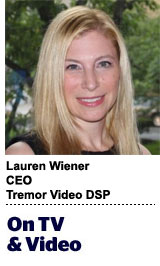 “On TV And Video” is a column exploring opportunities and challenges in advanced TV and video.
“On TV And Video” is a column exploring opportunities and challenges in advanced TV and video.
Today’s column is written by Lauren Wiener, CEO at Tremor Video DSP.
During commercial breaks, half of viewers reach for a device, posing a challenge for TV advertisers. Brand recall falls by nearly half, from 47% to 25% [PDF], when there is a second screen.
With growing over-the-top (OTT) viewership and penetration of smart TVs and streaming devices, consumers have more control and higher expectations for the viewing experience, challenging advertisers to become more strategic and creative.
In the modern living room, timing is everything. Brands that fail to understand TV/digital fusion will get less value from their TV spend and leave themselves at a competitive disadvantage.
Savvy brands such as State Farm and Casper are turning the challenges into opportunities. They are creating highly targeted and personalized digital experiences that amplify television ads. They are also using customers’ changing preferences to improve storytelling and create more effective ads.
New syncing mechanisms can help deliver more targeted sequential messaging, going from one-to-many delivery to one-to-one. Take Bud Light’s Super Bowl 2018 strategy, for example. To accompany two TV ads, Bud Light digitally targeted viewers with three types of Snapchat ads, one of which was an interactive game that maintained the medieval theme of Bud Light’s TV spots. This TV/digital fusion made for a more memorable brand experience.
Respecting users’ changing preferences
Brands are rethinking what an ad experience should look and feel like. An ad doesn’t have to be shown repeatedly or create a jarring interruption from the programming.
In January, State Farm leveraged the popularity of the TV series “This is Us” by partnering with NBC to create three 30-second ads shot in the style of the show. State Farm tapped into viewers’ strong connection to the show and developed contextually relevant content. It also created digital and social platform versions of the spots with NBCUniversal’s digital partners, Vox Media and BuzzFeed. Social activation included a co-branded hashtag and call to action for fans to submit photos of items that are meaningful to them.
As attention spans continue to shrink, brands are experimenting with shorter forms of advertising. YouTube aired six-second ads during its streaming of the World Series, and Toyota and Microsoft ran short spots during the Winter Olympics. To promote its newly designed emoji bottles, Pepsi also used five-second online and TV ads.
These ads were all contextually relevant. For example, an ad served during a baseball game had a baseball theme.
Creativity key to standing out
Exemplary storytelling is also coming from challenger brands, such as Casper. Casper is renowned for its use of digital and traditional methods to establish a distinct brand voice. As part of its mission to stand out from more traditional competitors like Mattress Firm, Casper ran clever and rather bizarre 15-second television spots that featured an 800 number for an insomniac’s hotline superimposed over surreal visuals. The ads ran at 3 a.m. without Casper branding.
Consumers who called the phone number could choose from nine outlandish options, which included pressing #3 to “travel back in time to the 1990s” or #8 to “go out to breakfast.” Callers heard no mention of Casper unless they pressed #9, and even then, the sales pitch was indirect and offbeat.
These ads got people talking, online and off, garnered free publicity and furthered Casper’s reputation as an innovative brand that does things its own way. It also acknowledged that TV viewers almost always have their phones in hand, even in the middle of the night.
The rise in augmented reality (AR) and virtual reality (VR)
The smartphone makes it easier for brands to leverage emerging VR/AR technologies in their campaigns. Last November, BMW became the first brand to create a 3-D augmented-reality version of a product with Snapchat by using a custom Snapchat lens. BMW used digital ads to drive people to the virtual experience, in which they could explore the vehicle and change its size and color. Rather than risk losing viewers’ attention when they looked down at their phones, BMW owned the second screen and used it to its advantage.
It is becoming easier to create these types of memorable cross-channel experiences. Snapchat, Facebook, Google and Apple have all built or are building in-house studios to help brands more easily design assets for AR initiatives. Many ad tech companies are also developing in-house creative teams intended to help brands create VR/AR experiences.
Engagement rates explode when ads are customized to speak directly to viewers of specific TV events. If brands can create ad experiences that tie into memorable TV moments, they will make digital advertising more valuable, too.
TV advertising is still a $72 billion industry, but those TV ad dollars aren’t going as far as they used to. If brands are to make their TV investment count, they have to remember that they are competing with the second screen. That means they need creative storytelling that stands out and reflects customer preferences.
They can also make their television spend go further by leveraging the second screen to their advantage and seeing it as an extension of their campaign, rather than as a competitor.
Follow Lauren Wiener (@LaurenJWiener) and AdExchanger (@adexchanger).
This post was syndicated from Ad Exchanger.

More Stories
Marketing Morsels: Hidden Valley Ranch, La-Z-Boy, Topps & More
Flashback: Jane Pauley and Deborah Norville Revisit Today’s 1989 Succession Drama
Ally Financial Revives ‘Banksgiving’ With A TikTok Twist